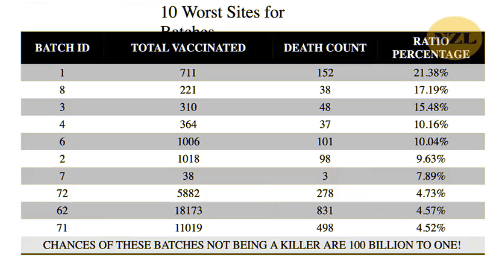In the last couple of weeks a New Zealand whistleblower came forward with detailed, but anonymized data showing that certain batches of the experimental you-know-what, were associated with shockingly high mortality rates. As this news started to spread, the government could have responded to correct or explain this, instead they arrested him, thus accidentally verifying that the data he showed was not wrong, but real. His crime apparently was not faking-up the data, but “accessing a computer system for dishonest purposes” which seems like a very strange crime given that, as he describes it, he was paid to work with the data, and the results of public health data is — in a free society — supposed to be public.
In the world we thought we lived in, we would assume that the NZ government would already know and track the mortality of all the batches they forced the citizens to take. Unless they were grossly incompetent or inherently corrupted by, hypothetically say, large multinational entities earning a hundred billion dollars — authorities would have the real death rates at their fingertips, surely? So if he faked the data, or misinterpreted it, or he made an honest but calamitous error with the spreadsheet, then surely the government could have told us that?
Perhaps there is some legitimate explanation (for example if the worst batches went to nursing homes with 104 year old patients at deaths door, or were only given to wards of Stage 4 cancer patients). The Minister of Health could have explained that. But check these numbers: The batch labelled “1” here had a death rate of 21%. Out of 711 injections, 152 people died. (Apparently over a long timespan, so some of these deaths are months afterwards.) This needs explaining.
The ten worst batches:
Batch 62, which went out to 18,000 people was associated with an extraordinary 4.6% death rate. Does the Minister know the average age of these people, or their risk factors? If not, why not? Isn’t this one of the most important questions in the country today?
In this short video below, Barry Young is interviewed by Liz Gunn, and referred to as “Winston Smith”. The man is a hero. In court he received a standing ovation from the packed public gallery. This interview was a few days ago, before his name was revealed and he was arrested.
New Zealand Covid-19 vaccination database admin turns whistleblower and reveals how many people died after taking bad batches of the Pfizer vaccine. This must be investigated. If this data of mass vaccine casualties is real there must be accountability. pic.twitter.com/2QjkmRGJca
— Kim Dotcom (@KimDotcom) November 30, 2023
The New Zealand Ministry of Health says that only four people have died because of vaccination. Steve Kirsch has analyzed the data, and claims it (and other data he has) shows an overall mortality rate of around 1 in 1,000 doses. He calls for people to prove he is wrong and points out no nation has ever released their record-level data publicly, which would be easy to do if they wanted to prove their programs were safe.
This new whistleblower data comes from the “Pay per dose” program in New Zealand and applies to about 4 million of the 12 million total doses. While one critic claimed these were doses for people in nursing homes, Kirsch claims that nearly 900 million days of data in people under 60 in the dataset. Kirsch also says the mortality peaks around six months after the last injection.
He pointedly asks why other countries don’t release their record-level data (which could show the injections are safe, right?) I don’t know if Steve Kirsch is right, but I do know the governments are acting guilty.
This week Barry Young was held overnight in jail and finally released on bail Tuesday after a long but strangely unexplained delay. As the Otago Daily Times explains it, the main fear of the government is apparently to stop the spread of anonymous data (presumably in case other people accidentally analyze it?)
Te Whatu Ora [some NZ Government entity] was granted an urgent injunction on Friday to prevent the spread of the data, chief executive Margie Apa said.
“The data, as published on an overseas site, appears to have been anonymised. Analysis of the released data is ongoing, but work so far has not found any National Health Index Numbers or personally identifiable information.”
For more information people can watch the full 1 hour interview here. Or read the Gateway Pundit write up, the latest Otago Daily Times, and Steve Kirsch’s blog.

